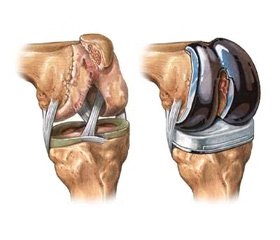Журнал «Травма» Том 15, №4, 2014
Вернуться к номеру
Indications and Contraindications for Arthroplasty of Tumor Defects of the Knee Joint Bones
Авторы: Klimovitsky F.V., Babosha V.A., Grebenyuk Yu.A., Abu-Faddeh Hasam, Yutovets Yu.A., Solonitsyn Ye.A. -
Donetsk National Medical University named after M. Gorky, Donetsk, Ukraine
Рубрики: Травматология и ортопедия
Разделы: Клинические исследования
Версия для печати
The question now conserving surgery or mutilating (amputation, disarticulation) with the possibility of the first is not necessary. Challenge remains how much surgery should be performed to comply with all the requirements onkoortopedii: 1) radicality at possible low risk for the patient's life (compliance with zoning and casing) 2) ablastics (prevention of recurrence); 3) preservation of the limb and its basic functions (Zatsepin ST, 2001; Babosha VA et al., 2008; Vyrva OE, 2012, etc).
Radicalism and preservation of limb function can be accessed by removing the entire tumor focus, which is achieved in malignant tumors of defect in three ways arthroplasty (Alexander Vorontsov, 1982; Neverov VA et al. 1997; Vyrva OE, 2012 etc.). This pole, subchondral and modular total hip replacement.
Purpose. Dermine, given the nature of the tumor of bone, forming the knee, tumor grade, the general condition of the patient, the possibility of acquiring the endoprosthesis, indications and contraindications for such operations.
Materials and Methods. The paper analyzes the treatment of 68 patients with benign and malignant neoplastic lesions of the distal femur - at 46, the proximal tibia - in 22. Men were aged 36 M ± m = 37 ± 3,2 years, women - aged 32 M ± m = 43 ± 1,9 years. Depending on the location of the tumor in the distal femur and proximal tibia endoprosthesis accomplished in three ways.
Results and Discussion. Hemiarthroplasty performed in 42 cases (distal femur - 24, the proximal tibia - 18), subchondral arthroplasty - 15 (distal femur - 11, proximal tibial - 4), individual modular (total) hip replacement - 11 (only the distal femur).
Before surgery for a malignant tumor was performed under a regional intraosseous wiring administering cytostatics (doxorubicin, lipodoks, methotrexate), determining its effectiveness by the developed method (patent of Ukraine UA № 2900 G01 № 33/50). Saving knee arthroplasty after subchondral contributed to higher functional outcome compared with single-pole and total hip replacement. The lower estimate for hemiarthroplasty explained earlier development of osteoarthritic changes in the joint.
Cancer arthroplasty result depended on the development of distant metastases that were not detected before surgery, as well as recurrence of the resected tumor in 20 patients, necessitating amputation - in 18. After two operations and more than 45 years of living (66.2 %) patients.
Conclusions. Analysis of the results knee arthroplasty in three ways possible to develop an algorithm of treatment tactics, including indications and contraindications for this kind of surgery in bone tumors forming the knee.

